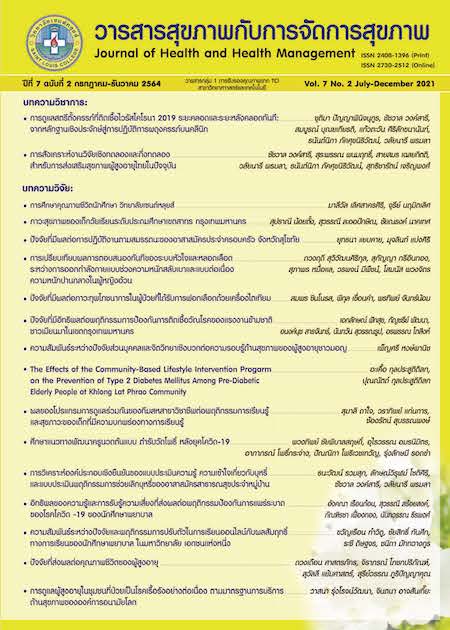Health Status of the Primary School-age Children, Sathorn District, Bangkok
Keywords:
health status, health problems, school age children, factors related to health behaviorAbstract
The objectives of this study were 1) to survey the prevalence rate of health problems, 2) to explore the health behaviors, and 3) to investigate the factors related to health behaviors among primary school-aged children. The samples comprised of 458 grade 6 students in Sathorn District, Bangkok. The data were collected by 3 sets of self-administered questionnaires which were 1) the health status and health behavior assessment form, 2) EQ assessment form and 3) SDQ screening form developed by Mental Health Department with .89, .90 and .79 of Alpha’s Cronbach Coefficient, respectively. Data were analyzed by frequency, percentage, mean and Chi-Square test.
The main findings were: 5.4 percent of the students were underweight while 11.2 percent were overweight according to the criterion. 7.2 percent were short. 50.4 percent of the students had dental caries. 27.5 percent and 22.3-31.0 percent of the students had EQ score and SDQ score below normal range respectively. Factors related to nutritional behaviors were self-weight recognition in weight (= 10.873), having self-discipline in activities related to weight control (
= 11.554) and benefiting from being in shape (
=9.211) and factors related to emotional health were having time to talk with their parents (c2=9.583), having a career goal (
=7.181) and being inspired (
=14.402) and factors related to health behaviors were having time to talk with their parents (
=8.457), having a career goal (
=5.782) and received rewards or being commended (
=3.957).
Suggestion: School activities to correct nutritional behavior should focus on correcting awareness of students' weight and the benefits of having the appropriate behaviors. The family or school staff have to regularly provide time for the students. Recommend Appropriate television programs for career and life inspiration should be recommended to the students.
References
กรมพินิจและคุ้มครองเด็กและเยาวชน. (2560). จำนวนร้อยละของคดีที่เป็นการกระทำผิดซ้ำที่ดำเนินคดีโดยสถานพินิจทั่วประเทศ [ออนไลน์]. สืบค้น 8 มกราคม 2561, จาก https://djop.thaijobjob.com/201701/index.php
กรมสุขภาพจิต กระทรวงสาธารณสุข. (2560). แบบประเมินความฉลาดทางอารมณ์เด็กอายุ 6-11 ปี. [ออนไลน์]. สืบค้น 8 มกราคม 2561, จาก https://dmh-elibrary.org/items/show/40
กรมสุขภาพจิต กระทรวงสาธารณสุข. (2560). แบบประเมินจุดแข็งและจุดอ่อน (SDQ). [ออนไลน์] สืบค้น 8 มกราคม 2561, จาก http:// www.appcenter.mhc5.net/sdq/
กลุ่มประเมินผลและนิเทศติดตาม กองแผนงานกรมอนามัย. (2563). รายงานประจำปี 2563 กรมอนามัย. กรุงเทพฯ: อักษรกราฟฟิคแอนด์ดีไซน์.
คณะกรรมการตรวจสอบและประเมินผล ภาคราชการกลุ่มกระทรวง คณะที่ 2. (2562). รายงานการพัฒนาเด็กปฐมวัย. [ออนไลน์]. สืบค้นเมื่อ 9 มกราคม 2560 จาก https://www.nesdc.go.th/ewt_w3c/ewt_dl_link.php?nid=10104
ทวีศิลป์ วิษณุโยธิน, วิมลรัตน์ วันเพ็ญ, ศศกร วิชัย, พัชรินทร์ อรุณเรือง, จันทร์ชนก โยธินชัชวาล, ธนโชติ เทียมแสง, หนึ่งฤทัย ยี่สุ่นศรี, ธัชกร ป้ายงูเหลือม, และนภาพรรณ ล่าเต๊ะ. (2556). การสำรวจสถานการณ์ปัญหาพฤติกรรมเสี่ยงและการติดเกมในนักเรียน โรงเรียนนำร่องระบบการดูแลช่วยเหลือนักเรียน. นนทบุรี: สถาบันสุขภาพจิตเด็กและวัยรุ่นราชนครินทร์ กรมสุขภาพจิต กระทรวงสาธารณสุข.
วิชัย เอกพลากร, ลัดดา เหมาะสุวรรณ, นิชรา เรืองดารกานนท์, วราภรณ์ เสถียรนพเกล้า, และหทัยชนก พรรคเจริญ. (2557). รายงานสำรวจสุขภาพประชาชนไทยโดยการตรวจร่างกายครั้งที่ 5 ฉบับสุขภาพเด็ก พ.ศ. 2557. กรุงเทพฯ: สถาบันวิจัยระบบสาธาณสุข.
วนิษฐา เหลืออรุณ, สุวิมล ตริกานันท์, และบุญมี พันธุ์ไทย. (2559). การศึกษาเปรียบเทียบความสามารถในการเอาชนะอุปสรรคของนักเรียนชั้นมัธยมศึกษาปีที่ 1 สังกัดกรุงเทพมหานครที่มีรูปแบบการอบรมเลี้ยงดูต่างกัน. พิฆเนศวร์สาร, 12(1), 87-101.
สถาบันราชานุกูล. (2559). การสำรวจสถานการณ์ระดับสติปัญญา (IQ) และความฉลาดทางอารมณ์ (EQ) เด็กไทยวัยเรียน และ ปัจจัยที่เกี่ยวข้อง. [ออนไลน์]. สืบค้นเมื่อ 9 มกราคม 2560 จาก https://th.rajanukul.go.th/preview-5122.html
สำนักทันตสาธารณสุข กรมอนามัย กระทรวงสาธารณสุข. (2561). รายงานผลการสำรวจสภาวะสุขภาพช่องปากแห่งชาติ ครั้งที่ 8 ประเทศไทย พ.ศ.2560. นนทบุรี: สามเจริญพานิชย์ จำกัด.
พงษ์ศักดิ์ น้อยพยัคฆ์, วินัดดา ปิยะศิลป์, วันดี นิงสานนท์, และประสบศรี อึ้งถาวร. (2557). Guideline in Child Health Supervision. กรุงเทพฯ: สรรพสาร จำกัด.
อัจศรา ประเสริฐสิน. (2553). ผลกระทบของพฤติกรรมการรับสื่ออินเตอร์เน็ตต่อสุขภาพกายและสุขภาพจิตของเด็กและเยาวชนไทย: กรณีศึกษากรุงเทพมหานคร. วารสารศรีปทุมปริทัศน์ ฉบับมนุษยศาสตร์และสังคมศาสตร์, 10(2), 54-62.
Green, L. W., & Kreuter, M. W. (1999). Health promotion planing third edition an educational and ecological approach (3rd ed.). California: Mayfield publishing company.
World Health Organization. (2013). Oral Health Surveys - Basic Methods. (5rd ed.). Geneva: World Health Organization Library.
Yamane, T. (1973). Statistics: An introductory statistics (Second Edition). New York: Harper & Row.
Downloads
Published
How to Cite
Issue
Section
License
Copyright (c) 2021 Journal of health and health management

This work is licensed under a Creative Commons Attribution-NonCommercial-NoDerivatives 4.0 International License.




